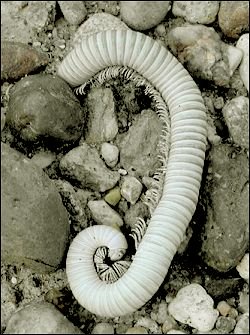
Try saying detritivore. Quite a mouthful, right? And that's partly what it's all about, because "detritivore" refers to an animal that eats detritus—the particles resulting from the disintegration of decaying organisms. These animals do desert plants a big favor by recycling material into substances they can use.
One of the most prominent of these animals is the millipede. Although
the name literally means a thousand feet, it really doesn't have that many. But
what it does have is two pairs of legs for every visible segment of its cylindrical
body, which may be as long as 5 inches. They are sometimes mistaken for centipedes, but
those predatory animals have flattened bodies and only one pair of legs per segment.
The difference between the two is important, because centipedes can inject painful,
though not especially dangerous, venom, while a millipede's defense is limited to
coiling itself up,  and if
further harassed, suddenly becoming, quite literally, a "little stinker".
and if
further harassed, suddenly becoming, quite literally, a "little stinker".
Listen to the Audio (mp3 format) as recorded by KTEP, Public Radio for the Southwest.
Contributor: Arthur H. Harris, Laboratory for Environmental Biology, University of Texas at El Paso.
Desert Diary is a joint production of the Centennial Museum and KTEP National Public Radio at the University of Texas at El Paso.

The exoskeleton of a desert millipede. The normal brownish color has bleached out during the several months since its death. Photograph by A. H. Harris.